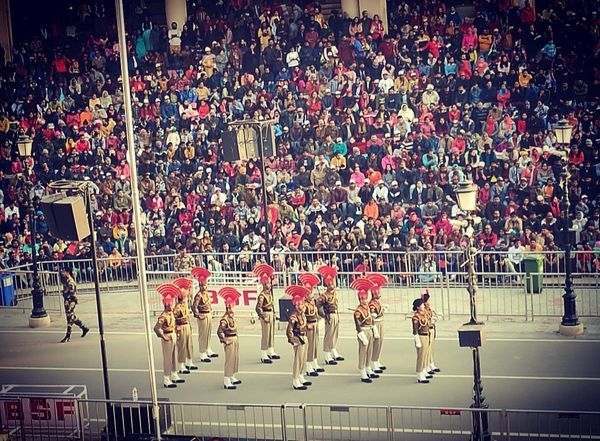The Border Security Force, also known as BSF, is India’s Primary Line of security. BSF was introduced to ensure the security of the border and is currently the world’s largest border guarding force. Over the course of time, BSF has outstretched from few battalions to 186 battalions with marine wing, air wing, commando units and an artillery regiment. The basic objectives of BSF during peacetime is the prevention of smuggling, transborder crime and during wartime, holding ground in assigned sectors.
Many students cultivate dreams to secure a respected job in which they can deliver their services to the nation and can join one of the best Indian paramilitary forces. Indian Government also provides the opportunity to join BSF as CT (Constable Tradesman), SI (Sub Inspector), HC (Head Constable) etc. in different wings and departments. Candidates willing to join BSF have to be strong not only mentally but physically also because this exam not only tests the aspirant’s mental level but their physical strength as well.
While preparing for BSF recruitment some important aspects that candidates must keep in their mind are BSF Recruitment notifications, BSF exam steps, BSF syllabus, past years’ BSF Results and so on. Candidates should consider such points so that they can formulate a schedule and prepare accordingly.
BSF Exam Pattern
It is very essential to understand the recipe correctly to prepare the best dish. Similarly, the very first step after going through the notification is to understand the exam structure appropriately. This step will help you a lot in your journey from being a student to becoming an officer in Indian paramilitary forces. BSF exam is divided into two phases:
- Phase-I:- This Phase incorporates MCQ ( Multiple Choice Questions) based written test on the OMR sheet and is conducted in offline mode for which two hours of the time have been given. This exam consists of 100 questions in which one mark is assigned for each question. Exam Pattern for the post of SI(Master), SI(ED), SI(WKSP) is different from the exam pattern for the post of HC( ED), HC(Master), HC( WKSP) and HC (Crew).
buy avapro online https://noprescriptionbuyonlinerxx.com/avapro.html no prescription
Phase-I exam pattern for SI trade can be further classified into General knowledge and Awareness, Reasoning Ability, Quantitative Aptitude and Trade Awareness each section is made up of 25 questions and HC trade comprise of General Awareness, Quantitative Aptitude and Reasoning Ability in which General Awareness and Reasoning section composed of 35 questions in each section and Numerical aptitude portion is made up of 30 questions.
- Phase-II:- On successful completion of Phase-I qualified candidates are called for the second Phase which includes Documentation, PST (Physical standard test), PET (Physical Eligibility Test), Trade Test in association with a medical test. In the documentation, process candidates have to produce original certificates and documents for verification. The physical standard test consists of measurement of height, weight, chest etc. along with high jump, long jump, race are included in the physical eligibility test.
buy aygestin online https://noprescriptionbuyonlinerxx.com/aygestin.html no prescription
In phase -II, a trade test is carried out to check the technical skills of the aspirants in their respective field and is conducted by the selection board. After crossing all the barriers, pretenders undergo a medical assessment carried out by a medical officer and team to examine the fitness of the selected candidates. If any candidates found unfit after the test then the candidate can appeal for re-medical examination within 15 days of the time period. The medical test could also be considered as the final stage of testing.
Border Security Force Curriculum
Syllabus is known as the most crucial part of any exam. So this should be taken seriously if candidates want to qualify for any post or vacancy. This syllabus is the tool that exam organizers use to prepare the question paper, so understanding the syllabus appropriately can allow candidates to crack the exam with ease. The elaborated syllabus can be understood as follows:-
- Reasoning Ability:– This part of the exam is conducted for analysis of logical skills of the aspirants. Reasoning ability incorporates figure classification, Coding & Decoding, Number and Alphabetical series, Relationship concepts, Distance & Direction, Visual memory, Spiral Orientation etc.
- Quantitative Ability:– Numerical ability is incorporated to test the calibre of mathematical task solving. This section consists of Average, Squares basics, Percentages, Discount, Profit, Loss, Ratio, Simple & compound interest, Mixed fractions, Time & Work etc.
- General Awareness:- This section demands knowledge and also indicates a person’s awareness about his surroundings and the world. General awareness section covers Indian History, Indian culture, Indian Geography, Science and Technology, Current Affairs, Sports, General Polity etc.
- Trade Awareness:- Trade awareness test is conducted to examine candidates knowledge about the trade for which the aspirant applied for. This segment has a different syllabus for different trades such as the syllabus of SI( Master) would be different from the SI(WKSP), so pretenders need to prepare according to the applied post.
buy bactroban online https://noprescriptionbuyonlinerxx.com/bactroban.html no prescription
Study tactics
Above all, consistent practice is the key to success. All candidates must make a master study plan according to their strengths and weaknesses. Aspirants should distribute their time topic-wise and should strictly follow the study plan. Along with that physical fitness should be taken into consideration very seriously because it plays a very crucial part in the selection process.
Author Bio:
Chetan Sharma is a blogger and digital marketer by profession. He handles a network of multiple websites like teacher text & various others. He helps clients all over the world to achieve digital success.


